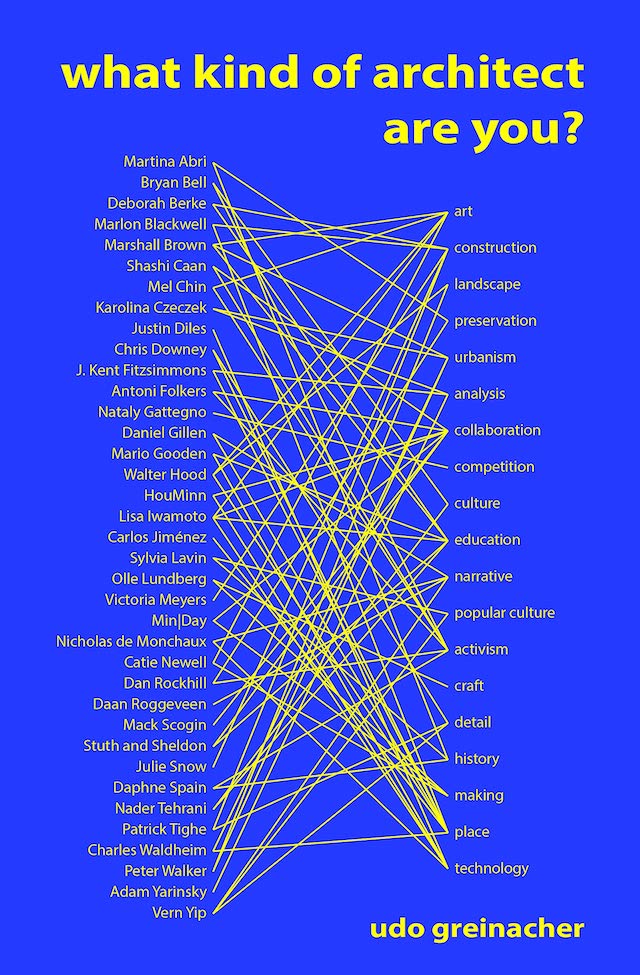What Kind of Architect Are You?
What Kind of Architect Are You?Udo GreinacherORO Editions, March 2021Paperback | 6 x 9 inches | 256 pages | 37 illustrations | English | ISBN: 9781951541569 | $25.00PUBLISHER'S DESCRIPTION:Architecture is commonplace. We inhabit it and use it; it is constantly present; it serves as foreground and background and usually has a story to tell. But apart from its most illustrious makers, we know almost nothing about the people who conceived it: the architects. What Kind of Architect Are You? offers a glimpse into a vast array of professional possibilities and points out meaningful alternatives to the prevailing myth of the “starchitect.” It provides those in search of an architect with insights into how we work and helps them to formulate expectations. It challenges practitioners to think introspectively and examine how they fit into the architectural spectrum. And finally, the collection documents the cross-section of cultural and architectural practice across America.Udo Greinacher teaches courses on film, futures, and urban issues at the University of Cincinnati. Born and raised in Tuebingen, Germany, he holds professional degrees in architecture from the Hochschule für Technik Stuttgart and the University of California at Berkeley.REFERRAL LINKS: dDAB COMMENTARY:The question "what kind of architect are you?" gets at the diversity of careers an architectural education enables. Architects can design buildings, their usual forté, but they can also write books, design landscapes, host a TV show, or teach. And teach would actually be more accurate, given how nearly all of the forty people interviewed by Udo Greinacher teach in addition to what could be called their primary work. And just as architectural education readies architects for more than just traditional practice, the vast realm of architecture is receptive to individuals with other degrees or training, as a few of the interviews reveal.If and when Greinacher asks his subjects the title question directly is not certain, since he adopts the approach of the great Studs Terkel, providing edited oral histories free of the interviewers question. Yes, some of the interviewees clearly repeat some questions back to him, but those are a rarity in the flowing texts that read like first-person glimpses into the minds of architects with whom I have varying degrees of familiarity. This last aspect made me wish short bios of the forty architects were included; while the narratives reveal much of who they are, short bios would help readers, like myself, determine which interviews are of most interest.A couple of the many highlights in the book are the interviews with Marlon Blackwell and Nicholas de Monchaux. Blackwell, now a familiar name to architects in and beyond the United States, recounts his path to Arkansas as a mix of personal conviction and opportunities, or lack thereof, after architecture school. He's very honest about working with his wife ("at times it's been difficult, because she has a very strong will, and I have a strong will also"), but most interesting is an anecdote about getting his work published twenty years ago. Unhappy with the coverage of a couple early projects in one magazine, he called up another one, met with the editor, and ended up getting a house on a cover of the latter. Conviction, in spades, but no hint of waiting for opportunities to arise.Nicholas de Monchaux is also an architect, but he is known for a book, Spaceship: Fashioning Apollo, that would appear to have nothing to do with architecture. But relate it does, born from graduate studies at Princeton focusing on domestic space and eventually taking up nine years of his life, overlapping with stints at Michael Hopkins' office in London and Diller + Scofidio in New York. Now based in the Bay Area and having written another book that explores technology and space, de Monchaux is proof that one answer to the question posed by Greinacher's book is, "any kind of architect."

ORO Editions, March 2021
Paperback | 6 x 9 inches | 256 pages | 37 illustrations | English | ISBN: 9781951541569 | $25.00
PUBLISHER'S DESCRIPTION:
REFERRAL LINKS:





